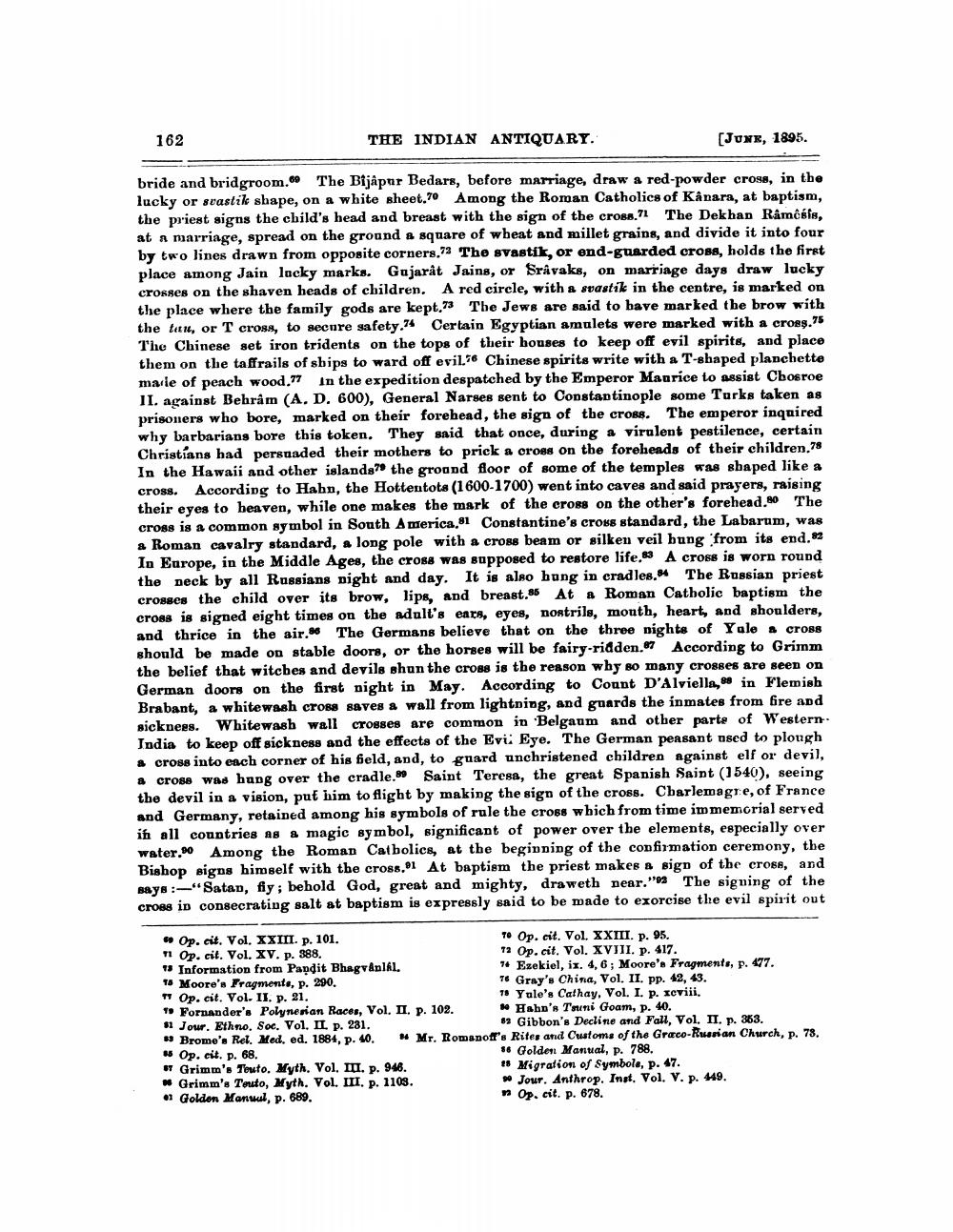________________
162
THE INDIAN ANTIQUARY.
(JUNE, 1895.
bride and bridgroom. The Bijapur Bedars, before marriage, draw a red-powder cross, in the lucky or svastik shape, on a white sheet.70 Among the Roman Catholics of Kanara, at baptism, the priest signs the child's head and breast with the sign of the cross.71 The Dekhan Râmēsls, at a marriage, spread on the ground a square of wheat and millet grains, and divide it into four by two lines drawn from opposite corners.73 The svastik, or end-guarded crose, holds the first place among Jain lacky marks. Gujarat Jains, or Sravaks, on marriage days draw lucky crosses on the shaven heads of children. A red circle, with a svastik in the centre, is marked on the place where the family gods are kept.73 The Jews are said to have marked the brow with the tetu, or T cross, to secure safety.74 Certain Egyptian amulets were marked with a cross.75 The Chinese set iron tridents on the tops of their houses to keep off evil spirits, and place them on the taffrails of ships to ward off evil.6 Chinese spirits write with a T-shaped planchette marie of peach wood.77 In the expedition despatched by the Emperor Maurice to assist Cbosroe II. against Behram (A, D, 600), General Narses sent to Constantinople some Turks taken as prisoners who bore, marked on their forehead, the sign of the cross. The emperor inquired why barbarians bore this token. They said that once, during a virulent pestilence, certain Christians had persuaded their mothers to prick a cross on the foreheads of their children.78 In the Hawaii and other islands7 the ground floor of some of the temples was shaped like a cross. According to Hahn, the Hottentots (1600-1700) went into caves and said prayers, raising their eyes to heaven, while one makes the mark of the cross on the other's forehead. The cross is a common symbol in South America,81 Constantine's cross standard, the Labarum, was a Roman cavalry standard, a long pole with a cross beam or silken veil bung from its end. 82 In Europe, in the Middle Ages, the cross was supposed to restore life,83 A cross is worn round the neck by all Russians night and day. It is also bang in cradles. The Russian priest crosses the child over its brow, lips, and breast.86 At & Roman Catholic baptism the cross is signed eight times on the adult's ears, eyes, nostrils, month, heart, and shoulders, and thrice in the air. The Germans believe that on the three nights of Yale cross should be made on stable doors, or the horses will be fairy-ridden. According to Grimm the belief that witches and devils shun the cross is the reason why so many crosses are seen on German doors on the first night in May. According to Count D'Alviello, in Flemish Brabant, a whitewash cross saves a wall from lightning, and guards the inmates from fire and sickness. Whitewash wall crosses are common in Belgaum and other parte of Western India to keep off sickness and the effects of the Evi Eye. The German peasant nsed to plough & cross into each corner of his field, and, to guard unchristened children against elf or devil, a cross was hang over the cradle.99 Saint Teresa, the great Spanish Saint (1540), seeing the devil in a vision, put him to flight by making the sign of the cross. Charlemagre, of France and Germany, retained among his symbols of rule the cross which from time immemorial served in all countries as a magic symbol, significant of power over the elements, especially over water. Among the Roman Catholics, at the beginning of the confirmation ceremony, the Bishop signs himself with the cross.o1 At baptism the priest makes & sign of the cross, and says :-"Satan, fly; behold God, great and mighty, draweth near." The signing of the croes is consecrating salt at baptism is expressly said to be made to exorcise the evil spirit out
* Op.cit. Vol. XXIII. p. 101.
To Op. cit. Vol. XXIII. p. 95. 11 Op. cit. Vol. XV. p. 388.
T2 Op.cit. Vol. XVIII. p. 417. + Information from Pandit Bhagvånikl.
74 Ezekiel, ix. 4,6; Moore's Fragments, p. 477. 15 Moore's Fragmente, p. 290.
76 Gray's China, Vol. II. pp. 42, 43. " Op. cit. Vol. II. p. 21.
78 Yule's Cathay, Vol. I. p. xcviii. 1Fornander's Polynesian Races, Vol. II. p. 102. # Hahn's Tsuni Goam, p. 40. $1 Jour. Ethno. Soc. Vol. II p. 231.
69 Gibbon's Decline and Fall, Vol. II. p. 363. * Brome's Rel. Med. ed. 1884, p. 40. Mr. Romanor's Rites and Customs of the Graco-Ruanian Church, p. 78. 45 Op. cit. p. 68.
** Golden Manual, p. 788. Grimm's Touto. Myth. Vol. II. p. 946.
15 Migration of Symbola, p. 47. Grimm's Touto, Myth. Vol. III. p. 1108.
Jour. Anthrop. Inst. Vol. V. p. 449. . Golden Mansul, p. 689.
n Op. cit. p. 678.




